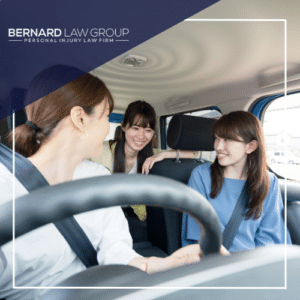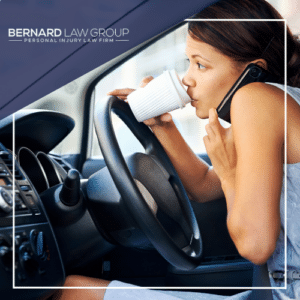Distracted driving is a serious issue across the country. Unfortunately, it is no different in Seattle.

The good news is that today, 91% of people buckle up in a vehicle. This shows there is hope for cases of distracted driving.
While true, some statistics related to distracted driving in Washington state are still shocking.
For example, “The Fatal Four” contributes to 5% of fatal accidents in Washington. This includes:
- Impairment
- Speeding
- Distraction
- Not wearing seatbelts
All of these are completely preventable causes of accidents and fatalities.
In 2022, distracted driving accounted for about 23% of deaths.
Surprisingly, fatalities in accidents in the state have increased, but the total number of crashes has gone down.
At Bernard Law Group, we represent clients who have been injured in distracted driving accidents all the time and understand the impact these can have on your life and the life of your family.
If you are injured in an accident, we are here to help. Contact our office to schedule a free consultation with our experienced car accident lawyer in Seattle.
Understanding Distracted Driving
Distracted driving, a major cause of road accidents, occurs when activities divert the driver’s focus from the road. This perilous behavior can lead to serious accidents, injuries, and fatalities.
Some of the most common causes of distracted driving include:
Mobile Phone Usage
The most prevalent cause of distracted driving is mobile phone use. Texting, calling, or browsing social media while driving significantly increases the risk of an accident. The momentary lapse in attention to operating a phone can have catastrophic results.
In-Vehicle Distractions
Distractions within the vehicle, such as eating, drinking, or adjusting the entertainment or navigation systems, pose significant risks. These actions require drivers to take their hands off the wheel and their eyes off the road, increasing the likelihood of an accident.
Conversations and Passengers
Interacting with passengers can also distract a driver. Engaging in conversations or attending to children or pets in the vehicle can divert attention from driving, leading to reduced reaction times in critical situations.
External Distractions
Outside events, such as other accidents, roadside events, or billboards, can catch drivers’ attention, leading them to inadvertently veer off course or miss important traffic signals.
Technology’s Impact
The advancement of in-car technologies and smartphones has exacerbated the issue of distracted driving. Features designed to enhance convenience, such as touchscreen interfaces and complex infotainment systems, require significant attention from drivers, detracting from road safety.



You Were Hurt. We Can Help.
Over $500 Million recovered for our past clients. Let us help YOU! Call 24/7 for your FREE injury consultation.
Common Injuries Seen in Distracted Driving Accidents
Distracted driving accidents can result in a wide range of injuries, varying in severity from minor to life-threatening. Understanding the common injuries associated with these accidents can help highlight the risks and consequences of distracted driving.
Whiplash and Soft Tissue Injuries
One of the most common injuries in car accidents, including those caused by distracted driving, is whiplash. This occurs when the force of the crash causes the head to snap forward and backward, straining or tearing the neck’s soft tissues.
Bone Fractures
The impact of a distracted driving accident can lead to bone fractures. The most frequently broken bones include ribs, arms, legs, and the pelvic area. These injuries often require lengthy recovery times and can affect mobility and quality of life.
Head and Brain Injuries
Traumatic brain injuries (TBI), concussions, and other head injuries are also prevalent in these accidents. They can result from the head striking the steering wheel, dashboard, windows, or other hard surfaces. Such injuries can have profound short-term and long-term impacts on the victim’s cognitive functions and emotional health.
Internal Injuries
The force exerted during a crash can cause internal injuries, including internal bleeding or organ damage. These injuries are particularly insidious because they might not be immediately apparent and can be life-threatening if not promptly treated.
Cuts and Lacerations
Glass from shattered windows and mirrors and metal or plastic debris can cause cuts and lacerations. While some may be superficial, others can be deep and require surgical intervention to prevent infection or more serious complications.
Spinal Injuries
Spinal injuries, including herniated discs and spinal cord damage, can occur in distracted driving accidents. These injuries can lead to significant pain, reduced mobility, and in severe cases, paralysis.
Proving Liability in Seattle Distracted Driving Accidents
In Seattle, distracted driving has become a growing concern as it significantly contributes to traffic accidents. Proving liability in such cases can be complex, but it is essential for victims seeking compensation.
Below, we outline the critical steps and considerations involved in establishing liability for distracted driving accidents.
Understanding Distracted Driving
Distracted driving encompasses any activity that diverts attention from driving. This includes three main types:
- Visual Distractions: Taking your eyes off the road, such as looking at a GPS.
- Manual Distractions: Taking your hands off the wheel, like eating or adjusting the radio.
- Cognitive Distractions: Taking your mind off driving, such as daydreaming or engaging in conversation.
Texting while driving is particularly dangerous as it involves all three types of distractions simultaneously.
Gathering Evidence
To prove liability in a distracted driving accident, comprehensive evidence is vital. Important types of evidence include:
Police Reports
After an accident, law enforcement officers usually document the scene and provide an official police report. This report often contains invaluable information such as:
- Statements from drivers and witnesses
- Conditions of the road
- Any citations issued, particularly if one party was cited for a distracted driving offense
Witness Statements
Eyewitnesses can provide crucial third-party accounts that corroborate the victim’s narrative. Their statements can illustrate how the distracted behavior directly led to the collision.
Phone Records
In cases involving mobile phone use, obtaining the driver’s phone records can be instrumental. These records can show whether the driver was texting or making a call at the time of the accident, substantiating claims of distraction.
Surveillance Footage
Nearby traffic cameras or surveillance systems from local businesses can capture the accident as it happened. Footage can provide irrefutable evidence of the driver’s behavior leading up to the collision.
Working with Experts
Various experts can add weight to a liability claim:
Accident Reconstruction Specialists
These experts analyze the physical evidence from the crash scene to recreate the events leading up to the accident. Their findings can demonstrate how distracted driving played a role in causing the collision.
Medical Professionals
Doctors and other medical professionals can testify about the extent of the injuries sustained and how they correlate with typical distracted driving accidents, thereby linking the injuries directly to the incident.
Legal Considerations
Washington State has strict laws against distracted driving, including bans on using handheld devices. Understanding these laws is crucial:
- Revised Code of Washington (RCW): Distracted driving is legislated under RCW 46.61.672, emphasizing significant penalties for offenders.
- Negligence Per Se: In some cases, violating traffic laws (like prohibitions on mobile phone use) can automatically establish negligence, aiding in proving liability.
Building a Strong Case
To build a strong case for liability, it’s essential to compile all available evidence and expert testimonies systematically. Legal representation from experienced attorneys can make a significant difference, helping navigate the complexities of Washington’s laws and ensuring that all angles are covered meticulously.
Tips to Avoid Distracted Driving
Distracted driving remains a significant threat to road safety, and taking proactive measures can help prevent accidents. Below, we present essential tips to avoid distracted driving and ensure a safer driving experience for everyone.
Prepare Before You Drive
Proper preparation can significantly reduce the need to multitask while driving. Here are some steps to consider:
- Set Up GPS: Program your destination into your GPS before you start driving. Ensure the device is securely mounted where you can easily glance at it without taking your eyes off the road.
- Adjust Controls: Adjust mirrors, seats, climate controls, and sound systems before you put the car in motion. This minimizes the need to make these changes while driving.
- Store Items Securely: Make sure that loose items are securely stored so they do not become distractions during your trip.
Limit Mobile Phone Use
Mobile phones are a common source of distraction for drivers. To avoid this, consider implementing the following practices:
- Use a Hands-Free Device: If you must make or receive calls, use a hands-free device or Bluetooth technology. However, remember that even hands-free calls can be distracting.
- Activate Do Not Disturb Mode: Many smartphones have a “Do Not Disturb” mode specifically for driving. This feature can automatically silence notifications and send automated replies to incoming texts.
- Pull Over: If you need to make an urgent call or send a text, pull over to a safe location before doing so.
Avoid Multitasking
Keeping your focus solely on driving is critical for road safety. Here are some habits to practice:
- Eat Before Driving: Eating in the car is a common distraction. Consume meals and snacks before you begin your journey or wait until you reach your destination.
- Delegate Tasks: If you have passengers, ask for their help with tasks such as adjusting the radio, managing navigation, or responding to phone calls and texts.
- Avoid Complex Conversations: Engaging in emotionally charged or complex conversations can take your mind off the road. Save these discussions for when you are not driving.
Manage In-Car Distractions
Many distractions come from within the vehicle itself. Implement these strategies to remain focused:
- Limit Passenger Distractions: While passengers can be helpful, they can also be a source of distraction. Politely ask them to keep noise and movement to a minimum.
- Secure Pets: If you travel with pets, make sure they are safely secured in a carrier or using a pet seatbelt. This prevents them from moving around and distracting you.
- Plan Entertainment for Kids: If you have children in the car, provide them with safe and quiet activities to keep them occupied without demanding your attention.
Practice Mindful Driving

- Stay Focused: Concentrate on the task of driving. Keep your eyes on the road, hands on the wheel, and mind fully attentive to the driving environment.
- Take Breaks on Long Trips: Fatigue can increase the likelihood of distractions. Schedule regular breaks to rest and refresh when on long journeys.
- Use Technology Wisely: Modern vehicles come equipped with various safety features. Utilize technologies like lane departure warnings and collision avoidance systems to enhance your awareness on the road.
Avoiding distractions while driving is a crucial practice for maintaining safety on the road. By following these tips and remaining committed to focused driving, you can significantly reduce the risk of accidents.
The Bernard Law Group encourages all drivers to adopt these practices to ensure a safer driving environment for everyone. Remember, a moment of distraction can have serious consequences, so always prioritize safe driving.
Your Advocates in Distracted Driving Cases
At Bernard Law Group, we understand the effects of distracted driving accidents extend beyond the legal implications; we see the human impact. Spearheaded by our experienced car accident lawyers in Seattle, our mission is to deliver unparalleled legal support.
Tailored Legal Strategies
Each case that comes to our office is unique. This understanding is the foundation of our approach, guiding us to craft legal strategies that aim for success and resonate with our clients’ personal circumstances. We don’t just serve as your attorney; we’re your ally throughout this process.
Commitment to Communication and Excellence
The pillars of our practice are clear communication, empathy, and a relentless pursuit of excellence. We ensure you’re well-informed and at ease during each phase of your case. With Bernard Law Group, you’re choosing a partner committed to your well-being and successful outcome.
No Fee Unless We Win
Our contingency fee model reflects our firm belief in our capabilities and dedication to your cause. You will not incur any fees unless we secure a victory in your case. It’s our way of demonstrating our commitment to achieving the best possible outcome for you.
Choose Bernard Law Group for Help with Your Seattle Distracted Driving Claim
You’re not just getting legal representation by entrusting your distracted driving accident case to us. You’re gaining a team of advocates devoted to securing the justice and compensation you rightly deserve. Contact us today and take the first step towards regaining control of your life after a distracted driving incident.
Frequently Asked Questions About Distracted Driving in Seattle
What is considered distracted driving in Seattle?
Distracted driving in Seattle includes any activity that diverts your attention away from driving. This can encompass using a mobile phone, eating and drinking, talking to passengers, adjusting the radio, and any other actions that take your focus off the road.
Exchange contact and insurance details with the involved parties and collect contact information from any witnesses. It’s also important to seek medical attention even if you feel fine, as some injuries may not be immediately apparent.
What are the penalties for distracted driving in Seattle?
In Seattle, distracted driving penalties can include fines starting at $136 for a first offense and increasing to $234 for subsequent offenses. Additional penalties may apply if distracted driving results in an accident, causing injuries or property damage.
However, this presumption can be rebutted if the rear driver can provide evidence that the front driver behaved negligently, such as by stopping abruptly without reason.
How can I prove another driver was distracted during an accident?
Proving another driver was distracted requires gathering evidence such as witness statements, traffic camera footage, and cellphone records. Hiring an experienced attorney can significantly help in collecting and presenting this evidence effectively.
Do I need a lawyer for a distracted driving accident case in Seattle?
While you are not required to have a lawyer, it is highly recommended. A lawyer can navigate the legal complexities, gather critical evidence, and represent your best interests in court. They can also help maximize your compensation for injuries and damages.
How much does it cost to hire an attorney for a distracted driving case in Seattle?
The cost of hiring an attorney can vary. Many personal injury lawyers, including those dealing with distracted driving cases, work on a contingency fee basis. This means they only get paid if you win your case. Typically, the fee is a percentage of the settlement or court award, often between 25% and 40%.
What should I do immediately after a distracted driving accident?
Immediately after an accident, ensure everyone’s safety and call emergency services if necessary. Collect contact information from witnesses and the other driver, take photos of the scene, and avoid admitting fault. Documenting everything can be crucial for your case. Contacting an attorney as soon as possible can also provide guidance on the next steps.
How long do I have to file a lawsuit after a distracted driving accident in Seattle?
In Washington State, the statute of limitations for filing a personal injury lawsuit is generally three years from the date of the accident. However, specific circumstances can affect this timeline, so it’s wise to consult with an attorney promptly to ensure timely filing.
Can I receive compensation if I am partly at fault for the accident?
Washington State follows a comparative negligence rule where you can still receive compensation if you are partly at fault. However, your compensation will be reduced by your percentage of fault. For instance, if you are 30% at fault, your compensation will be reduced by 30%.
What types of compensation can I seek in a distracted driving accident case?
Victims of distracted driving accidents can seek various types of compensation, including medical expenses, lost wages, pain and suffering, property damage, and, in some cases, punitive damages. An attorney can provide a detailed assessment of what you may be entitled to.
How can I prevent distracted driving?
Preventing distracted driving involves proactive measures such as using hands-free devices, setting up your GPS before driving, storing loose items securely, and practicing mindful driving. Additionally, educating passengers about the importance of minimizing distractions and setting a good example for others can contribute to safer driving habits.


